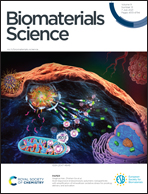18F-Labeled magnetic nanovectors for bimodal cellular imaging†
Abstract
Surface modification of nanocarriers enables selective attachment to specific molecular targets within a complex biological environment. Besides the enhanced uptake due to specific interactions, the surface ligands can be utilized for radiolabeling applications for bimodal imaging ensured by positron emission topography (PET) and magnetic resonance imaging (MRI) functions in one source. Herein, we describe the surface functionalization of magnetite (Fe3O4) with folic acid as a target vector. Additionally, the magnetic nanocarriers were conjugated with appropriate ligands for subsequent copper-catalyzed azide–alkyne cycloaddition or carbodiimide coupling reactions to successfully achieve radiolabeling with the PET-emitter 18F. The phase composition (XRD) and size analysis (TEM) confirmed the formation of Fe3O4 nanoparticles (6.82 nm ± 0.52 nm). The quantification of various surface functionalities was performed by Fourier-transform infrared spectroscopy (FT-IR) and ultraviolet-visible microscopy (UV-Vis). An innovative magnetic-HPLC method was developed in this work for the determination of the radiochemical yield of the 18F-labeled NPs. The as-prepared Fe3O4 particles demonstrated high radiochemical yields and showed high cellular uptake in a folate receptor overexpressing MCF-7 cell line, validating bimodal imaging chemical design and a magnetic HPLC system. This novel approach, combining folic acid-capped Fe3O4 nanocarriers as a targeting vector with 18F labeling, is promising to apply this probe for bimodal PET/MR-studies.



 Please wait while we load your content...
Please wait while we load your content...